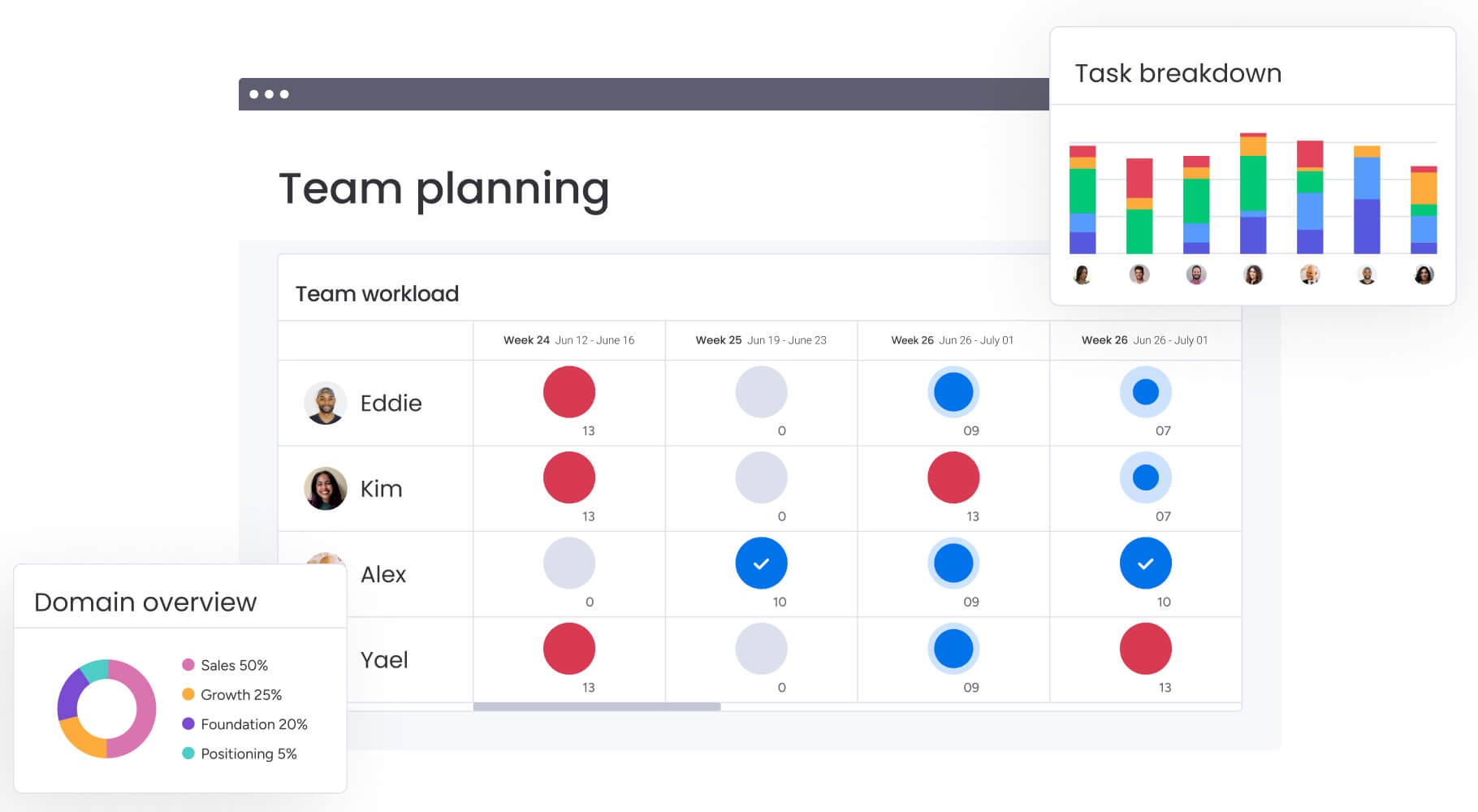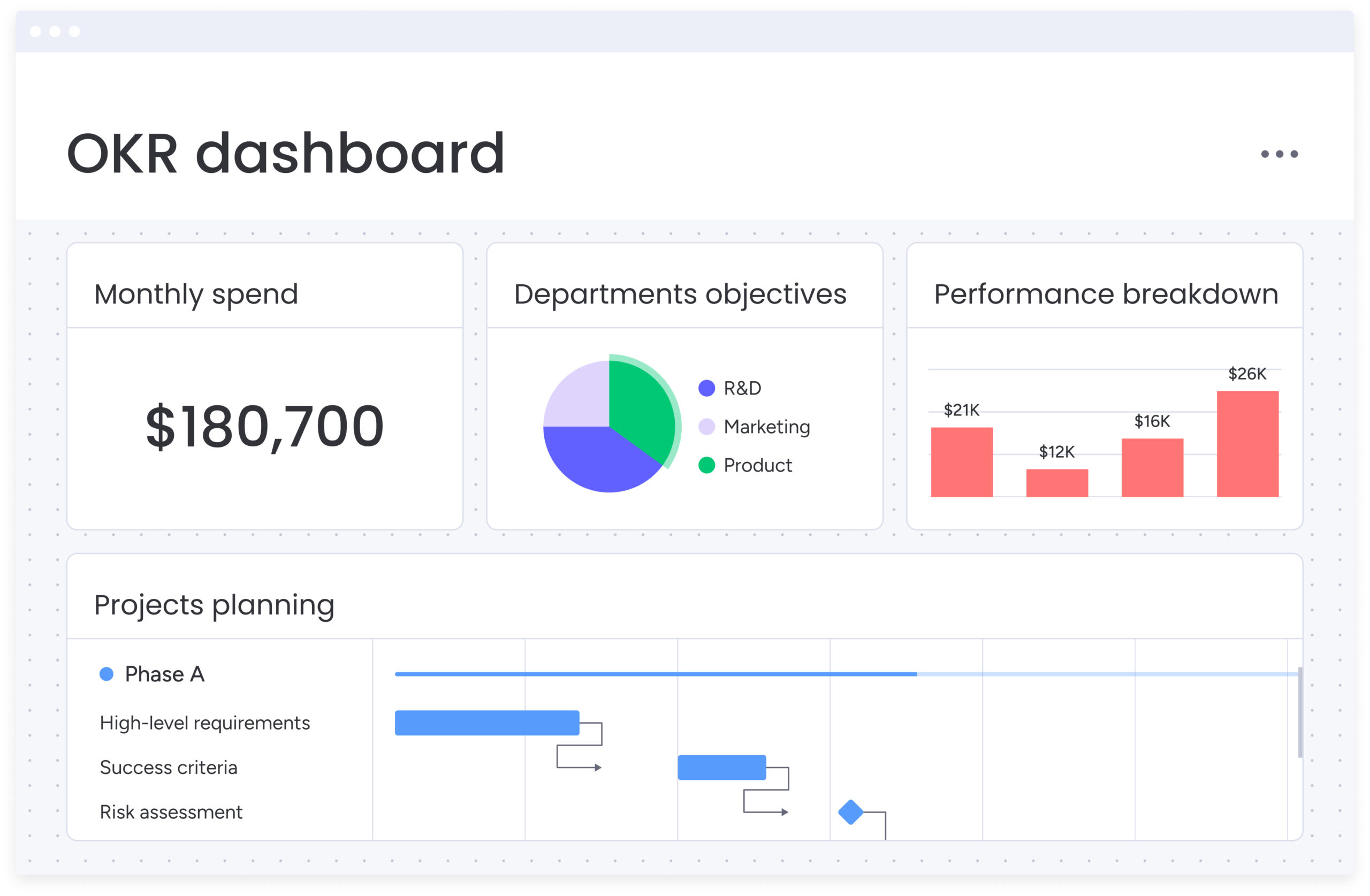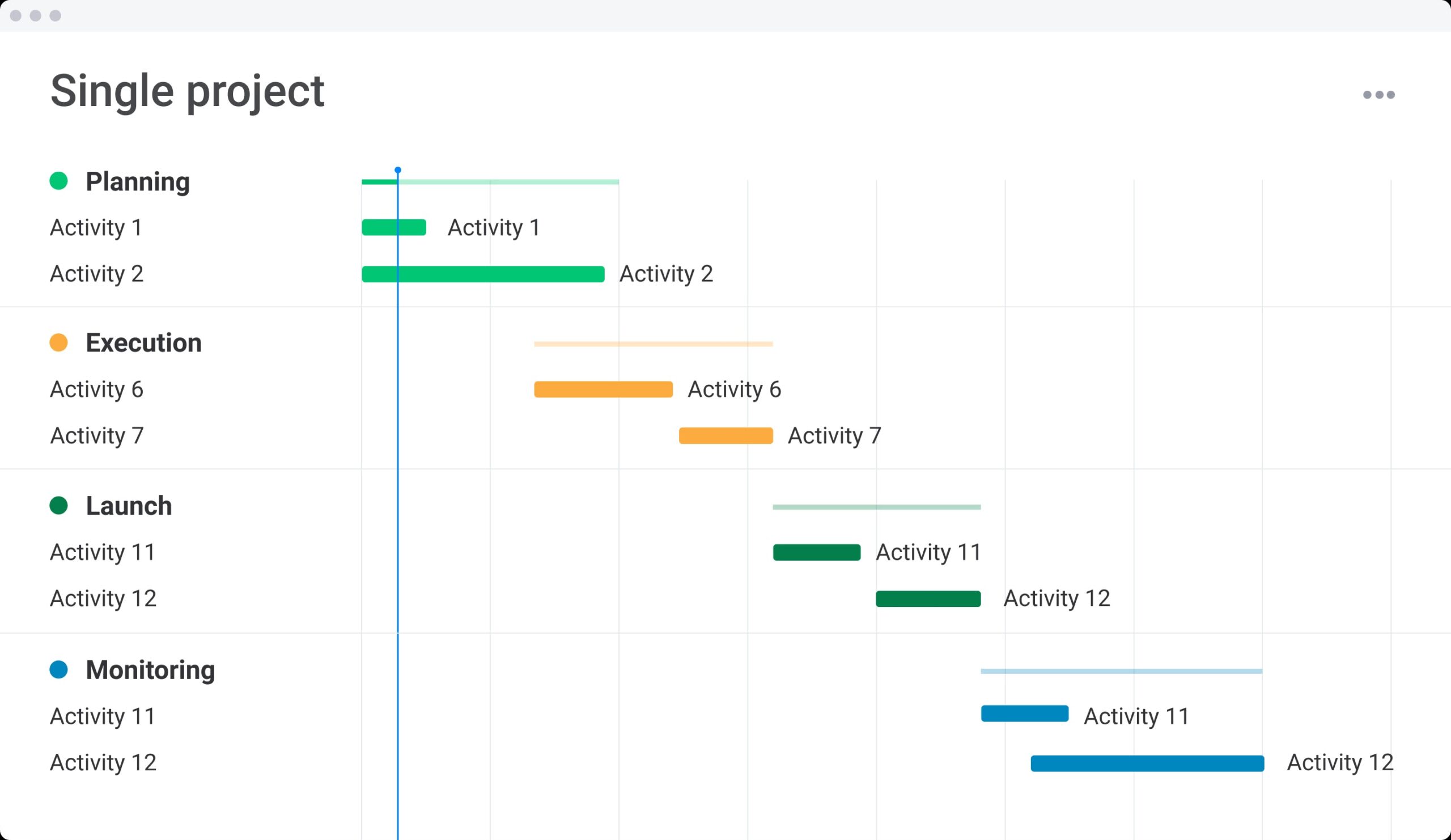A project strategy acts as your navigation system, helping teams chart a clear course toward business goals while avoiding hidden obstacles along the way. The most successful organizations don’t just execute projects; they align every initiative with their broader mission through thoughtful strategic project planning.
In this blog, you’ll learn how to assess your current performance, define clear goals, map out actionable steps, and leverage proven frameworks and tools to create a strategy that delivers real results. We’ll break down the five essential steps to move your team from scattered activity to focused, goal-driven action, and share practical tips for overcoming common challenges along the way.
We’ll also show you how you can start building your project approach with a platform that seamlessly connects planning to execution.
Try monday work managementWhat is project strategy?
A project strategy is a comprehensive plan that outlines the approach, actions, and measures needed to achieve specific project goals while supporting broader business objectives. It bridges organizational vision and tactical execution, providing a roadmap for teams to follow. Project strategy focuses on the “why” behind strategic initiatives and ensures alignment with company-wide priorities.
The key components of a robust project strategy include:
- Strategic alignment: How the project supports business goals
- Resource allocation: How teams, tools, and budgets are distributed
- Success metrics: How progress and outcomes are measured
- Risk assessment: How potential obstacles are identified and mitigated
Unlike day-to-day project management tasks , strategic project planning establishes the foundation upon which all tactical decisions are built.
The strategy-execution gap
Most organizations struggle to connect their strategic plans with actual execution. An effective project strategy closes this gap by creating clear connections between business goals and project activities.
Why project strategy matters for your organization
Organizations with well-defined project strategies complete their initiatives more successfully than those without strategic alignment. A thoughtful project strategy prevents scattered efforts and ensures resources are directed toward work that drives meaningful business outcomes.
The benefits of implementing strategic project planning include:
- Resource optimization: Teams focus on high-impact activities rather than spreading efforts too thin
- Clear accountability: Responsibilities are defined upfront, preventing confusion about who owns what
- Informed decision-making: A strategic framework provides context for prioritization when trade-offs are necessary
- Enhanced adaptability: Teams can pivot more effectively when they understand the underlying strategic intent
Without a project strategy, organizations often experience disconnected initiatives, wasted resources, and difficulty measuring true business impact.

5 steps to develop a winning project strategy
Strategic project planning follows a systematic approach that transforms business objectives into actionable plans. Each step builds upon the previous one to create a cohesive strategy that teams can execute with confidence.
Step 1: Align with business goals
Begin by identifying the specific business objectives your project will support. Review your organization’s strategic plan, annual goals, or OKRs to understand the larger context.
When defining your business alignment, consider:
- Business priorities: Which organizational goals will this project advance?
- Strategic impact: How will success be measured from a business perspective?
- Problem solving: What strategic challenges will this project address?
Document this alignment in a simple format that can be easily shared with all team members and referenced throughout the project.
Step 2: Define clear success metrics
Transform strategic objectives into measurable outcomes by establishing specific KPIs for your project. Distinguish between output metrics (what will be produced) and outcome metrics (what impact will be achieved).
Effective project metrics might include:
- Business impact: Revenue increase, cost savings, customer satisfaction improvements
- Quality indicators: Error rates, customer feedback scores, compliance measures
- Efficiency measures: Time saved, resource utilization, process improvements
- Strategic advancement: Market share gains, competitive positioning, innovation metrics
Build a dynamic dashboard that not only visualizes your chosen metrics throughout the project lifecycle, but also allows for real-time updates and interactive views tailored to different stakeholders. Incorporate automated data feeds to ensure your KPIs reflect the most current information, and include features like color-coded status indicators, milestone tracking, and risk alerts.
Review and share these dashboard insights broadly across your team and with stakeholders to keep everyone aligned, informed, and able to respond proactively to changes or new opportunities in real-time.

Step 3: Map out resources and stakeholders
Identify all resources needed for successful execution, including team members, budget, tools, and time. Create a comprehensive stakeholder map that outlines who will be involved, their roles, and their communication needs.
Consider these key elements when mapping resources:
- Team capacity: Available working hours, skills, and expertise
- Budget requirements: Initial estimates and contingency funds
- Technology needs: Systems, platforms, and integrations
- Timeline constraints: Deadlines, dependencies, and milestones
Effective resource mapping prevents bottlenecks and ensures teams have what they need to execute the strategy successfully.
Step 4: Choose frameworks and tools
Select the project management approach that best suits your project’s needs, whether Agile , Waterfall, or a hybrid methodology. The right framework provides structure while allowing for appropriate flexibility.
When selecting work management platforms to support your strategy, look for solutions that offer:
- Visualization: Tools like Gantt charts and Kanban boards for planning
- Collaboration: Features that support team communication and coordination
- Automation: Capabilities that reduce manual work and human error
- Reporting: Dashboards that track progress against strategic goals
The right tools make strategic project planning more efficient by centralizing information and creating transparency across teams.
Try monday work managementStep 5: Monitor and adapt continuously
Establish regular checkpoints to review progress against your strategic objectives and make necessary adjustments. Schedule formal review sessions at key milestones and encourage ongoing feedback from team members and stakeholders.
Effective monitoring includes:
- Weekly check-ins: Address immediate challenges and tactical adjustments
- Monthly reviews: Assess alignment with business goals and strategic direction
- Quarterly evaluations: Conduct deeper analysis of progress and make larger adjustments
- Continuous feedback: Gather input from stakeholders and end users throughout the process
Remember that a good project strategy evolves based on new information, changing market conditions, and lessons learned during execution.

Common project challenges and how to overcome them
Even with careful planning, teams often encounter obstacles when implementing project strategies. Understanding these challenges in advance helps you prepare effective solutions.
1: Complex cross-departmental workflows
When projects span multiple departments, information silos and competing priorities can derail strategic alignment. Overcome this challenge by establishing a centralized work management platform where all departments can collaborate.
Strategic project planning works best when information flows freely across organizational boundaries. Regular cross-departmental sync meetings help maintain alignment and address interdependencies before they become bottlenecks.
2: Unclear roles and accountability
Role confusion leads to duplicated efforts, missed deliverables, and strategic drift. Address this by creating detailed responsibility matrices at the outset of your project.
Effective accountability systems include:
- Documented roles: Clearly defined responsibilities for each team member
- Regular check-ins: Consistent follow-up on deliverable status
- Transparent tracking: Visible progress monitoring for all commitments
- Recognition: Celebration of milestone achievements and team contributions
When everyone understands their part in executing the strategy, teams move forward with greater confidence and fewer delays.
3: Inadequate tracking or reporting
Without proper visibility into progress, it’s difficult to know if your project strategy is on track. Implement comprehensive tracking systems that connect daily activities to strategic outcomes.
Effective reporting should:
- Show real-time status: Provide current information on strategic initiatives
- Highlight risks: Identify potential blockers that need attention
- Connect metrics: Link project activities to business objectives
- Provide insights: Offer actionable information for decision-making
Visual management tools help teams maintain strategic focus by making progress tangible and highlighting areas that need attention.
Strategic project planning tips for success
Beyond the core steps, these additional practices can elevate your project strategy from good to exceptional.
1: Standardize communication
Establish clear protocols for how project information will be shared, stored, and updated. Create templates for status reports, decision logs, and meeting agendas to ensure consistency.
Effective communication standards might include:
- Daily updates: Quick status checks for tactical coordination
- Weekly reports: Comprehensive progress tracking for the team
- Stakeholder briefings: Regular updates for executives and sponsors
- Issue escalation: Clear channels for addressing blockers and concerns
Standardized communication reduces confusion and ensures critical information reaches the right people at the right time.
2: Encourage feedback
Create multiple channels for gathering input from team members, stakeholders, and end users throughout the project lifecycle. Make it safe for people to share concerns or suggest improvements to the strategy.
When teams feel their input matters, they become more invested in the strategic outcome and more likely to identify potential improvements. This creates a culture of continuous improvement that strengthens your strategic project planning process.
3: Leverage automation
Identify repetitive tasks within your project workflow that could be automated. Look for opportunities to streamline processes, reduce manual effort, and minimize human error.
Areas where automation adds particular value include:
- Status updates: Automatic progress tracking and reporting
- Approvals: Streamlined review and authorization workflows
- Data collection: Automated gathering of metrics and feedback
- Resource updates: Dynamic allocation based on changing needs
Modern work management platforms offer no-code automation capabilities that make it easy to streamline processes without technical expertise. monday work management, for example, allows you to automate routine tasks such as status updates, task assignments, and deadline reminders.
You can set up custom triggers and actions to automatically move tasks between boards, notify team members of changes, collect feedback, and update project dashboards in real time. This automation not only reduces manual effort and human error but also enables your team to focus on high-impact work while ensuring processes run smoothly in the background.

Elevate your team’s impact and collaboration
A well-crafted project strategy transforms how teams work together and deliver results. By connecting everyday activities to larger business goals, strategic project planning creates meaning and direction that motivates teams to excel.
Organizations that master this discipline gain a significant competitive advantage through faster execution, better resource utilization, and more consistent achievement of business objectives. The most successful strategies provide enough structure to keep teams aligned while allowing for adaptation as conditions change.
FAQs
What is the difference between project strategy and project management?
Project strategy focuses on the “why” and “what” of projects—aligning initiatives with business goals and determining the approach—while project management focuses on the “how,” dealing with day-to-day execution, timelines, and resource coordination.
How often should I review and update my project strategy?
You should review your project strategy at regular intervals (monthly for short projects, quarterly for longer ones) and whenever significant business changes occur that might impact your strategic direction or goals.
What are the key elements of an effective project strategy?
An effective project strategy includes clear business alignment, well-defined success metrics, comprehensive resource planning, appropriate methodologies/frameworks, risk assessment, and feedback mechanisms for continuous improvement.
How do I ensure my project strategy aligns with organizational goals?
Ensure alignment by starting with organizational goals as your foundation, involving key stakeholders in strategy development, creating traceability between project objectives and business outcomes, and regularly validating that connection throughout the project lifecycle.
What tools are most helpful for strategic project planning?
The most helpful tools for strategic project planning provide visualization capabilities, centralized information, customizable workflows, real-time reporting, and collaboration features—work management platforms like monday work management offer these capabilities in one integrated solution.
How can I measure the success of my project strategy?
Measure project strategy success through a combination of quantitative metrics (KPIs tied to business goals) and qualitative assessments (stakeholder satisfaction, team feedback), comparing actual outcomes against the strategic objectives established at the outset.
